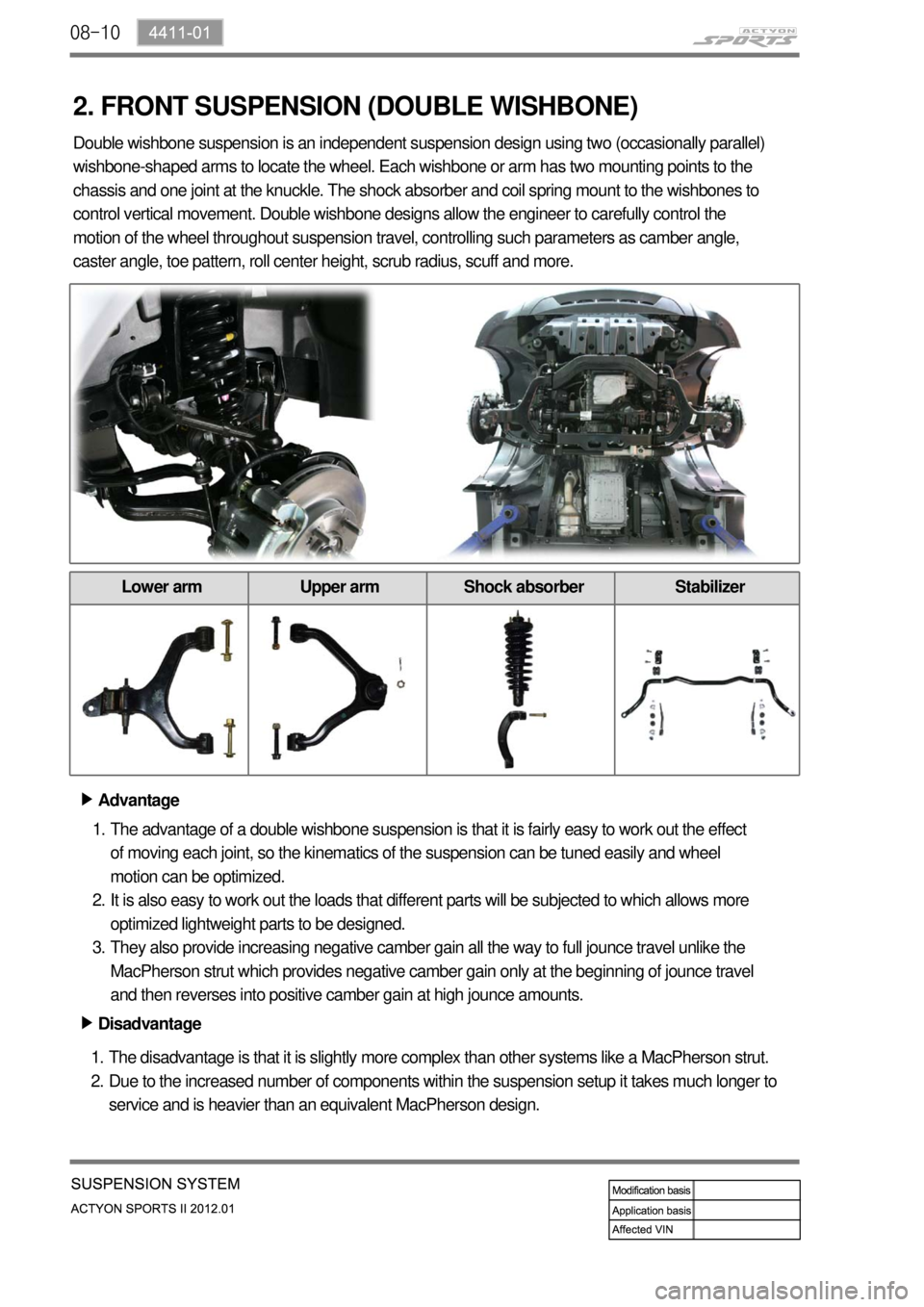Page 627 of 828
07-33240-01
1. SPECIFICATIONS
Description Specifications
Type Part-time transfer case
Total length 343 mm
Mating surface of front flange 40 mm
Weight 32.4 kg (including oil)
Oil capacity 1.4 L
Oil type ATF DEXRON III
Location Transfer case
Major element Housing Part-time & TOD
Bolt 11 ea, M8 x 1.25
Input shaft A/T: outer spline
M/T: inner spline
Page 631 of 828
07-73240-01
1) Components Location
Magnet clutch power supply connector (for 1 pin)
Transfer case main connector
Shift motor connector
Rear propeller shaft
Oil filler plug
(Tightening torque: 19 ~ 30 Nm)
Transfer case assembly
Front propeller shaft
T/C motor
Oil drain plug
(Tightening torque: 19 ~ 30 Nm)
Damper
Page 639 of 828
08-34411-01
1. SPECIFICATIONS
2. WHEEL ALIGNMENT
Description Specification
Front SuspensionSuspension typeDouble wishbone
Spring typeCoil spring
Shock absorber typeReciprocating cylindrical type (gas type)
Stabilizer bar typeTorsion bar type
Rear SuspensionSuspension type5-link type
Spring typeCoil spring
Shock absorber typeReciprocating cylindrical type (gas type)
Stabilizer bar typeTorsion bar type
Front
Wheel
AlignmentToe-in2 ± 2 mm [0~4mm]
CamberLH-0.19° ± 0.25°
RH-0.29° ± 0.25°
CasterLH4.4° ± 0.4°
RH4.5° ± 0.4°
Page 640 of 828
08-4
3. SYSTEM LAYOUT AND TIGHTENING TORQUE OF
FRONT SUSPENSION
Upper arm assembly
Coil spring
Shock absorber
Front axle shaft assembly
Steering gear
box assembly Lower arm assembly
Shock absorber yoke
Knuckle assembly
Stabilizer bar assembly
Front View ▶
Upper arm (on knuckle) nut
Tightening torque: 140 ~ 160 Nm
Lower arm (on knuckle) nut
Tightening torque: 140 ~ 160 Nm
Shock absorber (to yoke) bolt
Tightening torque: 125 ~ 145 Nm
Page 641 of 828
08-54411-01
Stabilizer bar link lower nut
Tightening torque: 110 ~ 130 Nm
Coil spring mounting nut
Tightening torque: 60 ~ 80 Nm
Stabilizer bar link upper nut
Tightening torque: 30 ~ 50 NmUpper arm (frame side) bolt/nut
Tightening torque: 110 ~ 130 Nm
Stabilizer bar clamp bolt
Tightening torque: 40 ~ 60 Nm
Lower arm (end yoke) bolt
Tightening torque: 70 ~ 80 Nm
Lower arm (shock absorber yoke side) nut
Tightening torque: 150 ~ 170 Nm
Lower arm (frame side) bolt/nut
Tightening torque: 210 ~ 230 Nm Top View ▶
Page 642 of 828
08-6
4. SYSTEM LAYOUT AND TIGHTENING TORQUE OF REAR
SUSPENSION
Lower arm (link)
Stabilizer bar link
Stabilizer bar
Shock absorber
Coil spring seat (upper side)Lateral rod
Axle housing Upper arm (link)Top View ▶
Page 644 of 828
08-8
5. TROUBLESHOOTING
Problem Cause Action
Vehicle rollingBroken stabilizer bar Replace
Faulty shock absorber Replace
Abnormal noise.Loosening mounting Retighten
Damaged or worn wheel bearing Replace
Damaged shock absorber Replace
Damaged tire Replace
Poor ridingOver inflated tire Adjust pressure
Faulty shock absorber Replace
Loosened wheel nut Tighten as specified torque
Bent or broken coil spring Replace
Damaged tire Replace
Worn bushing Replace
Vehicle pulls to one sideDeformed arm assembly Replace
Worn bushing Replace
Bent or broken coil spring Replace
Hard steeringExcessive resistance of lower arm
ball jointReplace
Insufficient tire pressure Replace
Faulty power steering Replace
Unstable steering
Worn or loosened lower arm
bushingRetighten or replace
Vehicle bottoming
Worn or broken coil spring Replace
Vehicle height loweredOver loaded on the vehicle -
Defective shock absorber Replace
Defective coil spring Replace
Page 646 of 828

08-10
2. FRONT SUSPENSION (DOUBLE WISHBONE)
Advantage ▶
The advantage of a double wishbone suspension is that it is fairly easy to work out the effect
of moving each joint, so the kinematics of the suspension can be tuned easily and wheel
motion can be optimized.
It is also easy to work out the loads that different parts will be subjected to which allows more
optimized lightweight parts to be designed.
They also provide increasing negative camber gain all the way to full jounce travel unlike the
MacPherson strut which provides negative camber gain only at the beginning of jounce travel
and then reverses into positive camber gain at high jounce amounts. 1.
2.
3.
Disadvantage ▶
The disadvantage is that it is slightly more complex than other systems like a MacPherson strut.
Due to the increased number of components within the suspension setup it takes much longer to
service and is heavier than an equivalent MacPherson design. 1.
2. Double wishbone suspension is an independent suspension design using two (occasionally parallel)
wishbone-shaped arms to locate the wheel. Each wishbone or arm has two mounting points to the
chassis and one joint at the knuckle. The shock absorber and coil spring mount to the wishbones to
control vertical movement. Double wishbone designs allow the engineer to carefully control the
motion of the wheel throughout suspension travel, controlling such parameters as camber angle,
caster angle, toe pattern, roll center height, scrub radius, scuff and more.
Lower arm Upper arm Shock absorber Stabilizer